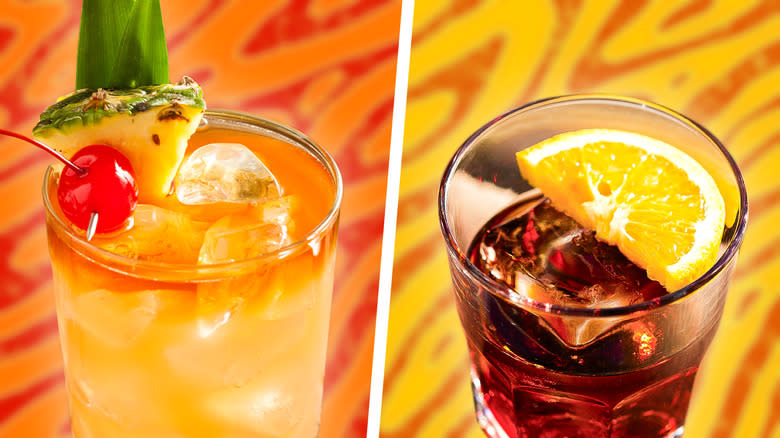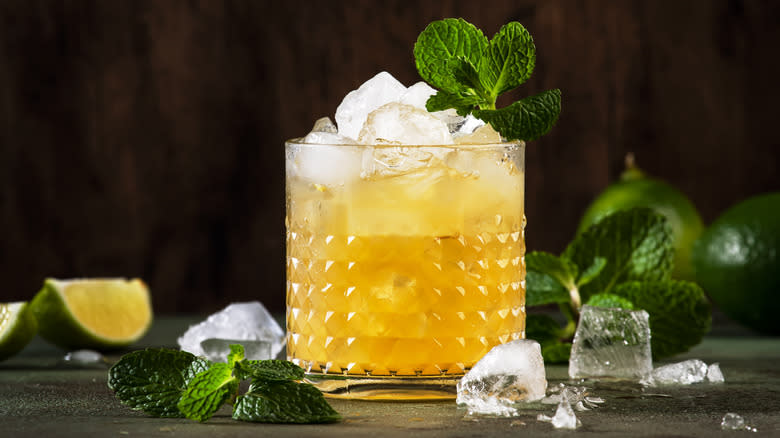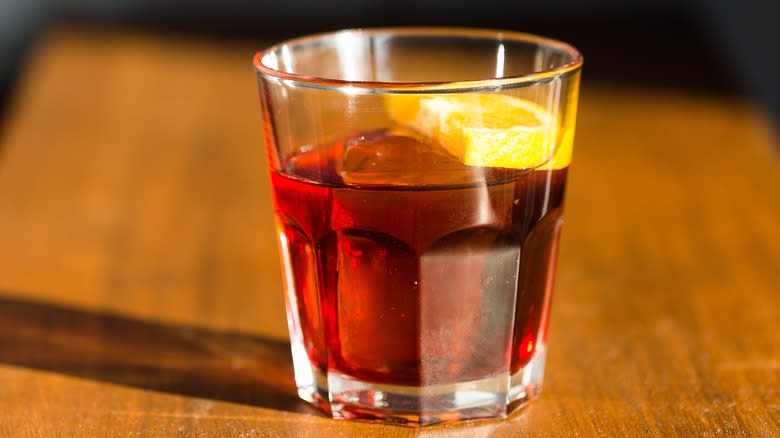Mai Tai Cocktail Vs Mi-To: What's The Difference?

Mai Tai and Mi-To may sound very similar, but in the world of cocktails they couldn't be much more different. Names are a tricky thing when it comes to drinks, as there can be a lot of different ways to order the same thing, and small adjustments to ingredients can create something entirely new. Want a martini? You'll have to get way more specific considering all the variations. Want to try gin in your daiquiri instead of rum? Sorry, that's called a gimlet now. So you could be forgiven for thinking that Mi-To is some quirky type of Mai Tai, or that one evolved from the other, but in both taste and origins, the two drinks are oceans apart.
The Mai Tai was born in the United States, an invented pastiche of tropical drinking, although that doesn't make it any less tasty. The Mi-To is one of the oldest cocktails we have, dating all the way back to Italy in the mid-19th century, and giving rise to a whole group of drinks that became more famous than their progenitor. The Mai Tai is sweet, spiced, and tart, while the Mi-To is simple and bitter. In fact, given the tiki drink's unique ingredients, you might not even be able to order a Mai Tai in the type of bar where you'd order a Mi-To. But the one thing they have in common is that they are both classics, and they are both worth knowing and experiencing.
Read more: The 40 Absolute Best Cocktails That Feature Only 2 Ingredients
What Is A Mai Tai?

The Mai Tai tastes like it comes from someplace exotic and warm, but it was actually invented in either the 1930s or 40s in the U.S. It is most commonly attributed to Victor Bergeron, aka "Trader Vic," owner of his eponymous bar and restaurant, although Donn Beach, aka "Don the Beachcomber," also claims to have invented a similar drink. A classic tiki cocktail from the glory days of the trend, the original Mai Tai is a mixture of aged rum with lime, orange curaçao, orgeat, and simple syrup. Cheaper versions and pre-made mixes will include orange juice, pineapple juice, or other ingredients, but the true Mai Tai is a relatively simple drink that uses Caribbean flavors and adds a little twist with the orgeat syrup. It's also traditionally garnished with a spent lime shell and a sprig of mint.
The flavors of a proper Mai Tai are complex, with a profile that's lightly sweet, tangy, and bright. The orgeat syrup, which is an almond syrup from France, gives the drink an incredible depth and much of its unique floral, nutty aroma. However, the cocktails were made specifically to showcase aged Jamaican rums — originally a 17-year-old J. Wray and Nephew bottle — and the tasting notes of molasses, spice, and vanilla in those rums are essential to the best versions of the drink. The Mai Tai may not have originated in the tropics, but it makes full use of its most popular flavors.
What Is A Mi-To?

Everything about the Mi-To is right there in its abbreviated name. "Mi-To" is a shortened version of Milano-Torino, and the drink is named for the two famous Northern Italian cities. It consists of an equal mix of Campari, which is from Milan, and sweet vermouth, which is traditionally associated with Turin. The Mi-To was supposedly created in the 1860s at the Caffee Camparino in Milan, a bar owned by the creator of Campari himself. It's made by simply mixing the two liquors together, pouring over ice, and garnishing with an orange wedge. Anyone who is a fan of Campari can probably already recognize that the Mi-To eventually spawned the Americano, which adds soda water, and the Negroni, which adds gin.
The Mi-To has a bitter, herbal taste thanks to the Campari, which is slightly cut by the sweeter red vermouth. That bitter profile is popular in Italy for aperitifs, which are drinks made to be sipped before meals to stimulate the appetite. While aperitifs are often straight drinks, like vermouth, Campari, or Lillet, the Mi-To helped popularize aperitif cocktails, making it the forerunner of drinks like the Aperol Spritz. While the original drink may have been overtaken by the cocktails that evolved from it, aperitif cocktails and spritzes have only been gaining in popularity, and the Mi-To is a great place to start if you want to give those flavors a try.
Read the original article on Tasting Table.

